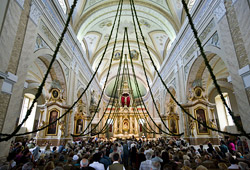Indulgenced Feast Traditions
This Way of the Cross was established in 1639, and in 1644 Pope Urban VIII granted indulgences for several of its chapels. After the image of Mary and Jesus brought to Samogitian Calvary from Rome was declared miraculous in 1643, and after the new Church of the Visitation of the Blessed Virgin Mary was built, the shrine’s previous annual feast was expanded to form the July 2-12 celebration known either as the “Indulgenced Feast of the Visitation” or the “Great Indulgenced Feast of Samogitian Calvary”. In 1649, precisely on the Sunday following July 2, the relic of the Holy Cross from the Dominican monastery at Lublin arrived at Samogitian Calvary. Ever since then, the Sunday after July 2 has been known as the “Great Calvary” and is the day on which the main solemnities of the annual feast are held. The Church of the Visitation has become the nucleus of the shrine’s Way of the Cross. Processions of pilgrims set out from here to follow the Way of the Cross, and also end up here afterwards.
The fame of the Indulgenced Feast of the Visitation spread greatly during the 18th century. Samogitian Bishop Antanas Tiškevičius (1692–1762) contributed to this when in 1748 he urged parish priests in the area to organize trips to the feast at Samogitian Calvary. People would come in large groups, singing hymns, playing instruments and waving parish banners. The onslaught of pilgrims became such that not even the large wooden church built in 1750, with its 24 altars, was sufficient for the priests to offer Holy Mass for all donors’ intentions. Thus it was decided to build the larger, stone church, which arose in 1822.
During the years of Tsarist Russian occupation, crowds of people turned out for the annual feast at Samogitian Calvary from all parts of Lithuania, and even from other places. Processions along the Way of the Cross were continuous from the first rays of dawn until the late evening twilight, when candles lit the path. While tsarist authorities did occasionally create disturbances during the event, more often they simply worked to ensure public order. The Great Indulgence became the true spiritual hub of Samogitia.
The Marian Congregation, which came to the shrine in 1927, helped to organize the annual feasts between the two world wars, typically attracting 30 to 50 thousand people. The Marian Fathers maintained existing pious traditions at Samogitian Calvary, but also introduced a few new ones that were quickly espoused. Thanks to their enormous efforts, Samogitian Calvary’s fame spread even beyond Lithuania. When celebrating the shrine’s 300-year jubilee in 1939, they calculated that during those three centuries about 6 million people had visited the shrine.
Much was done to impede the indulgenced feast during the Soviet era. The government banned processions and bell ringing, limited access to the town (sometimes using force) and organized competing massive cultural events, like the so called “festivals” held at the time in Plateliai. Priests could not celebrate Mass at the shrine without a special permit, and only one or two such permits were granted during the feast. Threats and punishments were employed regularly seeking to reduce the scale of the indulgenced feast and of visits to the Way of the Cross in general. An effort to demolish the chapels was made in 1962. Parishioners managed to save them by standing watch day and night for weeks on end. Soviet militia and army units monitored the Great Indulgenced Feast of 1982, harassing and persecuting the participants.
The Marian shrine at Samogitian Calvary has remained one of Lithuania’s main spiritual centres even after the restoration of independence. One recent novelty in the indulgenced feast is the dedication of each day to people from a specific part of the Telšiai diocese, or from a specific profession, state of life or age. And each day the pilgrims who gather pray for a different important intention: for their homeland, for the Church, for vocations, for sobriety and so on.








